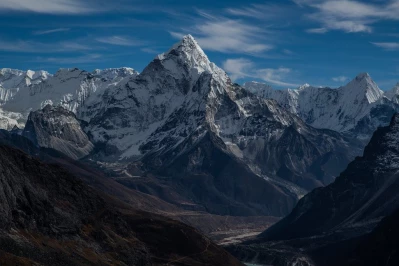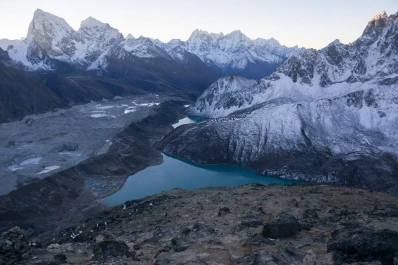
Exactly What You Need To Bring for the Greatness Everest Base Camp Tour
- 1. Mastering the Art of Packing Light
- 2. Dressing for the Elements: Understanding Nepal's Everest Base Camp Weather
- Clothing: Conquering the Elements
- Base Layer (Moisture-Wicking):
- Mid Layer (Insulation):
- Outer Layer (Protection):
- Additional Clothing:
- 3. Essential Gear: Tools for the Trail
- 4. Conclusion
Conquer Everest Base Camp! This guide equips you with the essential packing list for your trek. Master layering for all weather, discover what gear to rent or buy, and embark on an unforgettable Himalayan adventure.
Conquering Everest Base Camp Tour is an extraordinary adventure, but conquering your packing list can feel equally daunting. Fear not, intrepid trekker! This comprehensive guide equips you with the knowledge and essentials to tackle the elements and navigate the trails of the Khumbu region.
1. Mastering the Art of Packing Light
Luggage space on the trek is limited, so packing strategically is key. Here are some tips to maximize space and minimize weight:
- Invest in Multifunctional Clothing: Opt for versatile pieces you can layer throughout the day. Convertible pants that zip off into shorts, quick-drying shirts with built-in sun protection, and a warm fleece that doubles as a mid-layer are all space-saving heroes.
- Utilize Packing Cubes: These organizational marvels categorize your gear and compress bulky items, allowing you to fit more in your duffel bag.
- The Roll, Don't Fold Technique: Rolling clothes creates a space-saving, wrinkle-resistant packing style.
- Embrace the Power of Lists: Make a packing list well in advance and tick off items as you go. This ensures you haven't forgotten anything crucial.
2. Dressing for the Elements: Understanding Nepal's Everest Base Camp Weather
The Khumbu region experiences a wide range of weather conditions throughout the year. The trekking season typically falls between spring (March to May) and autumn (September to November). Here's a breakdown of what to expect:
- Spring: Spring offers pleasant daytime temperatures, ranging from 10°C (50°F) to 18°C (64°F). However, nights can be chilly, dropping to -5°C (23°F). Rain and occasional snowfall are also possibilities.
- Autumn: Autumn boasts clear skies and comfortable temperatures, with highs averaging around 15°C (59°F) and lows dipping down to -2°C (28°F). However, strong winds can be a factor, especially at higher altitudes.

Clothing: Conquering the Elements
Knowing the expected weather conditions will help you pack the right clothing for layering. Here's a breakdown of the clothing categories you'll need for Everest Base Camp Tour:
Base Layer (Moisture-Wicking):
- 2-3 Merino Wool T-shirts: Merino wool is naturally anti-odor and wicks away moisture, keeping you comfortable during exertion.
- 1 Pair of Merino Wool Long Johns: These provide warmth and wick away sweat, preventing chafing.
Mid Layer (Insulation):
- 1 Fleece Jacket: A lightweight fleece that offers warmth on chilly mornings and evenings.
- 1 Down Jacket (Optional but highly recommended for higher altitudes): A high-quality down jacket with a fill power of at least 650 will provide crucial warmth at Everest Base Camp.
Outer Layer (Protection):
- Waterproof Hiking Jacket: A good quality waterproof jacket with a breathable membrane is essential for unexpected rain or snow. Look for features like a hood, pit zips for ventilation, and taped seams to keep moisture out.
- Waterproof Hiking Pants: Durable waterproof hiking pants with good breathability are vital for protecting you from the elements.
Additional Clothing:
- 1 Pair of Hiking Socks: Choose moisture-wicking, breathable socks specifically designed for trekking. Pack enough pairs for the entire trek, with an extra pair for unexpected weather changes.
- 2-3 Pairs of Underwear: Opt for quick-drying, breathable fabric.
- Sun Hat with a Wide Brim: Protect yourself from the harsh Himalayan sun.
- Warm Hat: A beanie or fleece hat is essential for providing warmth at higher altitudes.
- Neck Gaiter: A versatile piece of gear that can be worn as a neck scarf, headband, or face mask.
- Buff/Bandana: Provides additional sun protection and can be used to wipe away sweat.
- Gloves: Pack a pair of lightweight liner gloves for chilly mornings and evenings, and consider a heavier pair of gloves for higher altitudes.
Footwear: Your Foundation on the Trail
- Trekking Boots: Invest in a sturdy, well-fitting pair of waterproof trekking boots with good ankle support. Break them in thoroughly before your trek to avoid blisters.
3. Essential Gear: Tools for the Trail
- Trekking Poles: These provide stability and support on uneven terrain, especially when navigating descents.
- Headlamp: A reliable headlamp with a spare set of batteries is crucial for early morning starts or navigating in low light conditions.
- Water Bottles or Hydration Bladder: Stay hydrated throughout the trek. Opt for a sturdy, insulated water bottle or a hydration bladder with a bite valve for easy access.
- Sunscreen (SPF 30 or higher) and Lip Balm: Protect your skin from the sun's harmful rays, especially during the spring season when UV rays are stronger due to thinner air at higher altitudes.
- Sunglasses: Choose a good quality pair of sunglasses with UV protection to shield your eyes from the sun's glare.
- Durable Duffel Bag: Most trekking companies will provide duffel bags for porters to carry your gear. Opt for a sturdy duffel bag with a comfortable carrying strap for your personal daypack.
Toiletries and Medications:
- Travel-sized toiletries: Pack the essentials like toothbrush, toothpaste, biodegradable soap, and hand sanitizer.
- Quick-drying travel towel: A lightweight, quick-drying towel is ideal for saving space and weight.
- Personal medications: Pack any necessary medications for the duration of the trek, with a slight buffer in case of delays.
- Blister Kit: A blister kit containing moleskin, antiseptic wipes, and anti-blister balm is a lifesaver on long treks.
- Diamox (Optional): Consult your doctor about the possibility of taking Diamox to help acclimatize to altitude.
- Water Purification Tablets: If you're not relying on bottled water throughout the trek, pack water purification tablets to ensure safe drinking water.
Electronics:
- Camera: Capture the breathtaking scenery of the Himalayas. Consider a lightweight, weather-resistant camera.
- Extra Camera Battery and Charger: Ensure you have enough power to document your entire adventure.
- Portable Charger: A portable charger will keep your phone and other essential electronics juiced up throughout the trek. Remember: Power availability is limited in the Khumbu region, so plan accordingly.
- Headphone Adapter: Many teahouses have limited power outlets, so an adapter that allows you to charge multiple devices simultaneously can be helpful.
Rent or Buy? Making Smart Gear Choices for Everest Base Camp Tour
While high-quality gear is essential, it's not always necessary to break the bank. Consider these factors when deciding to rent or buy specific equipment:
- Frequency of Use: If you don't see yourself embarking on similar treks in the future, renting specialized gear like down jackets and trekking poles might be a more economical option.
- Budget: High-quality gear can be expensive. Renting allows you to access top-of-the-line equipment without the upfront investment.
- Personal Preference: Some trekkers prefer the comfort and familiarity of their own broken-in gear.

4. Conclusion
By following this comprehensive guide and packing strategically, you'll be well-equipped to conquer the challenges and embrace the wonders of the Everest Base Camp trek. Remember, the right gear can make a world of difference in your comfort and enjoyment on the trail. So, pack smart, pack light, and get ready to embark on an unforgettable Himalayan adventure!
You've assembled your Nepal trekking Everest Base Camp gear! Now, the only thing missing is an unforgettable adventure. At Adventure Asia, we craft unique expeditions for experienced adventurers like you. We focus on soft/medium adventures beyond the typical itinerary, ensuring an immersive experience in the Himalayas. Contact Adventure Asia today and let's co-create your dream Everest Base Camp Tour!
- 1. Mastering the Art of Packing Light
- 2. Dressing for the Elements: Understanding Nepal's Everest Base Camp Weather
- Clothing: Conquering the Elements
- Base Layer (Moisture-Wicking):
- Mid Layer (Insulation):
- Outer Layer (Protection):
- Additional Clothing:
- 3. Essential Gear: Tools for the Trail
- 4. Conclusion





















